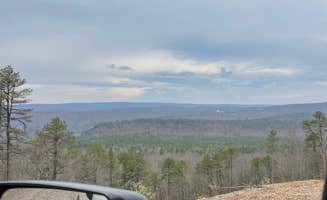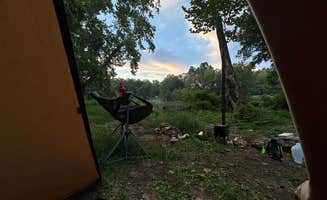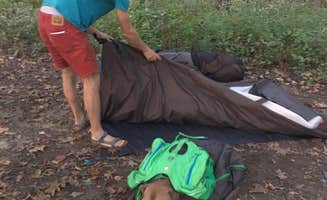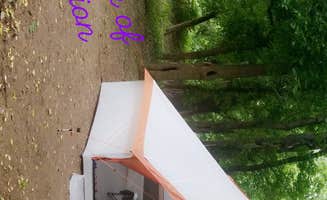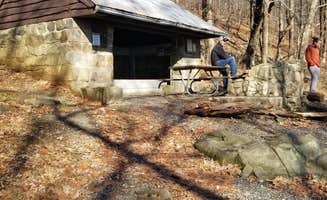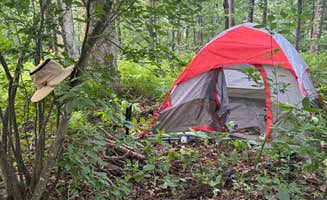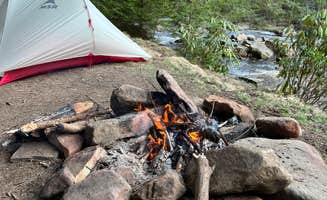Dispersed camping near Star Tannery, Virginia takes place within a region that spans elevations from 600 to 3,200 feet, creating distinct camping microclimates throughout the year. The terrain's varied topography contributes to unpredictable spring weather conditions, with temperature differences of up to 15°F between valley and ridge campsites. Forest roads accessing most primitive camping sites typically remain open from April through November, though closures may occur during severe weather events.
What to do
Hike to panoramic views: The Veach Gap trail offers a moderately challenging 4-mile uphill trek to ridgeline campsites with views of the Shenandoah River. "Breathtaking views of the Shenandoah River and surrounding mountains. Very much worth the 4 mile hike up to the site. 1,200ft elevation difference from the trailhead to the site," notes one Veach Gap camper.
Fish in nearby waterways: Edwards Run Wildlife Management Area provides accessible fishing opportunities, particularly for beginners. "Fun place to teach the kids the basics of fishing, but the campground area leaves a little to be desired," according to a visitor at Edwards Run.
Explore day hiking trails: The Wolf Gap Recreation Area serves as an excellent base for accessing regional trails. "There are several trails that intersect with the campsite and day hikers are a common site," reports a camper at Wolf Gap, where multiple established hiking routes connect directly to the camping area.
What campers like
Large, secluded sites: Wolf Gap Recreation Area features spacious individual camping areas. "Most sites have a paved parking platform and then a second tier for the camp site. All sites are quite large and include picnic tables, fire rings and large tent platforms. The campground itself is beautifully wooded. Each campsite is mostly secluded from the rest of the park," writes a visitor to Wolf Gap Recreation Area.
Riverside camping: South Fork Shenandoah River offers waterfront primitive camping with easy river access. "The road to get to the campsite was well maintained and easy to get to. Campsites themselves were a tad overgrown but it was the beginning of the season. Seemed to be about a dozen spots to camp. Each site had its own fire pit," shares a camper at South Fork Shenandoah River.
Weekday solitude: Many dispersed sites near Star Tannery see minimal weekday usage. "We camped during the week and had nobody else camping on weekdays," notes a visitor at Squirrel Hollow Road, describing the peaceful environment found midweek at these primitive camping locations.
What you should know
Self-registration systems: Little Fort Campground uses a unique site claim method. "You select a campsite by flipping a washer on a hook on the board from green to red. Flip it back when you leave," explains a Little Fort visitor, detailing the self-service board system.
Road access limitations: Many forest roads require cautious driving, especially in poor weather. "Long and winding road to get there with no service so be cautious," advises a Little Fort camper, highlighting the transportation challenges common throughout the area.
Site availability patterns: Popular camping areas fill quickly on weekends, especially during peak seasons. "Got the last site at 6PM on the Friday of Memorial Day weekend," reports a Little Fort visitor, indicating the importance of early arrival during busy periods.
Tips for camping with families
Check site facilities: Some primitive sites near Star Tannery offer minimal amenities for children. "Site had a fire pit, table, parking spot, and tent platform. Bathrooms and beer proof trash was provided. Nice trails/creek behind site," reports a camper at Little Fort, detailing the basic amenities available.
Consider noise factors: Some camping areas experience recreational vehicle traffic. "There's a lot by the road that looks like it's where they want you to camp but there are better sites on in. Just gotta hike to em," suggests a visitor at Edwards Run Wildlife Management Area, pointing to quieter alternatives away from main access points.
Pack extra supplies: Most primitive camping areas have no running water or supplies. "There's no running water here. I'll definitely stay here again. Oh on this app it says T-Mobile access, I'm a T-Mobile customer, no reception at all but drive 5 minutes back down the mountain and you're good to go," advises a Little Fort camper.
Tips from RVers
Check parking pad size: RV sites at dispersed camping areas vary significantly in size and levelness. "There are 9 campsites, each with at least one fire ring, a tent pad and a picnic table, and there is a vault toilet in the middle," explains a Little Fort camper, noting the limited size of available spaces.
Be prepared for uneven surfaces: Many camping areas have challenging parking situations. "Many of the car parking pads are not level. But the tent pads appear to be," shares a visitor at Wolf Gap Recreation Area, highlighting a common challenge for vehicle camping.
Consider small trailers only: Most primitive sites accommodate only compact RVs or teardrop trailers. "Sites are located less than a mile from the paved highway. We found 5 spots just off the road. All were easily accessible by car or with a small teardrop trailer," notes a camper at Squirrel Hollow Road Camping, emphasizing the size limitations.


